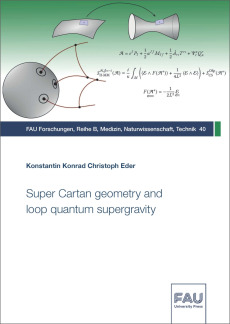Konstantin Konrad Christoph Eder
Super Cartan geometry and loop quantum supergravity
Reihe: FAU Forschungen : Reihe BSuperstring theory and loop quantum gravity (LQG) are promising approaches towards the formulation of a quantum theory of gravity. Superstring theory aims at unification of all fundamental forces of nature, predicting supersymmetry and even higher spacetime dimensions. LQG, on the other hand, takes a more conservative viewpoint by proposing new quantization techniques that take seriously the central principles of general relativity.
The goal of this work is to relate ideas from LQG and superstring theory by combining LQG with the concept of supersymmetry. To achieve this, the mathematical apparatus for a mathematically rigorous description of the underlying geometric structures of supergravity theories, i.e., supersymmetric extensions of Einstein’s theory of gravity, will be developed. Among other things, this approach leads to a reformulation of the theory in which (part of) supersymmetry manifests itself in terms of a gauge symmetry.
Using the interpretation of supergravity in terms of a super Cartan geometry, the Holst variant of the MacDowell-Mansouri action for (extended) AdS supergravity in D=4 for arbitrary values of the Barbero-Immirzi parameter – a free parameter of the theory – will be derived. Moreover, it will be demonstrated that these actions provide unique boundary terms that ensure local supersymmetry invariance at boundaries.
The chiral case is special: The action is invariant under an enlarged gauge symmetry, the boundary theory is a topological super Chern-Simons theory, and a chiral connection emerges that is the natural generalization of the Ashtekar connection to the supersymmetric context. Making use of the enlarged gauge symmetry, a quantization of the theory generalizing standard tools of LQG will be proposed.
These results provide a starting point for applications in the context of supersymmetric black holes and quantum cosmology. There, the enhanced gauge symmetry proves to be a promising tool which in the future may shed a lot of insights on how to relate results from these different approaches.
Die Superstring-Theorie und die Schleifenquantengravitation (LQG) sind vielversprechende Ansätze zur Formulierung einer Quantentheorie der Gravitation. Die Superstring-Theorie zielt auf die Vereinheitlichung aller fundamentalen Kräfte der Natur ab und sagt dabei Supersymmetrie und sogar höhere Raumzeitdimensionen voraus. Die LQG hingegen nimmt einen konservativeren Standpunkt ein, indem sie neue Quantisierungstechniken vorschlägt, welche die zentralen Prinzipien der allgemeinen Relativitätstheorie berücksichtigen.
Das Ziel dieser Arbeit ist es, eine Brücke zwischen LQG und der Superstring-Theorie zu schlagen durch Vereinigung der LQG mit dem Konzept der Supersymmetrie. Hierzu wird der mathematische Apparat für eine mathematisch rigorose Beschreibung der zugrundeliegenden geometrischen Strukturen von Supergravitationstheorien, d.h. supersymmetrischen Erweiterungen der Einsteinschen Gravitationstheorie, entwickelt. Dieser Ansatz führt u.a. zu einer Neuformulierung der Theorie, in welcher sich (zumindest ein Teil) der Supersymmetrie in Form einer Eichsymmetrie manifestiert.
Unter Verwendung der Interpretation der Supergravitation im Sinne einer Super-Cartan-Geometrie wird die Holst-Variante der MacDowell-Mansouri-Wirkung für (erweiterte) AdS-Supergravitationstheorien in D=4 für beliebige Werte des Barbero-Immirzi-Parameters – ein freier Parameter der Theorie – abgeleitet. Außerdem wird gezeigt, dass diese Wirkungen eindeutige Randterme liefern, die die lokale Supersymmetrie-Invarianz an den Grenzen sicherstellen.
Der chirale Fall ist ein Sonderfall: Die Wirkung ist invariant unter einer erweiterten Eichsymmetrie, die Randtheorie ist eine topologische Super-Chern-Simons-Theorie, und ein chiraler Zusammenhang tritt zutage, welcher eine natürliche Verallgemeinerung des Ashtekar-Zusammenhangs im supersymmetrischen Kontext darstellt. Unter Ausnutzung der erweiterten Eichsymmetrie wird eine Quantisierung der Theorie vorgeschlagen, die die Standardwerkzeuge der LQG verallgemeinert.
Diese Ergebnisse bieten einen Ausgangspunkt für Anwendungen im Kontext supersymmetrischer Schwarzer Löcher und Quantenkosmologie. Dort erweist sich die erweiterte Eichsymmetrie als ein vielversprechendes Werkzeug, das in der Zukunft viele Erkenntnisse zur Verknüpfung der beiden Theorien liefern kann.

